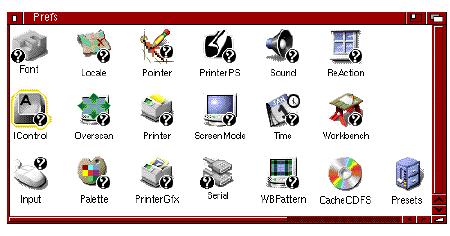
The Prefs drawer contains the icons for the Preferences editors and the Preset drawer. Figure 5-1 illustrates the Preferences editors window.

Preferences Window
The following editors are listed in the order in which they are described in this chapter:

With the exception of Time, each editor has three menus: Project, Edit, and Settings. The Project menu lets you save and load Prefs preset files, which allow you to quickly change to different configurations. By default, these files are saved in the Presets drawer (SYS:Prefs/Presets), although they can be saved to any location you specify. If you save icons for the files (by selecting Create Icons?), you can activate the settings by opening the file's icon, rather than opening the actual editor.
When you save settings in the Preferences editors by clicking on the Save button, the system stores those settings in the following location:
SYS:Prefs/ENV-Archive/Sys/editorx.prefs
where SYS: is the name of the volume containing the file and editorx is the name of the specific Preferences editor. The settings saved to the Env-Archive drawer are the ones used when you boot. We recommend when you use the Save As option that you use the path provided or a completely different path than this for storing Preset files.

The following Project menu options let you save the editor settings to a specific file and open previously saved files:

The Edit menu options allow you to restore previously used settings or the default settings. The options are:
|
Returns the editor settings to the last settings you saved with the Save gadget (not the Save As item). |
|
|
Returns the editor to the settings displayed when you opened the editor first. |
The WBPattern and Pointer Edit Menus have the following additional options:
|
Replaces the whole work area with the last thing cut or copied. |
|
|
Opens a file requester for entering the name of an image file to use as a background pattern or picture. |
These options make editing patterns and pointer images easier. Use Cut, Copy, and Paste to transfer images between the editor and a Clipboard-aware program with more extensive drawing tools, such as IconEdit. Use Load Image to import any standard IFF bitmap image into the editor. (Images larger than the editor work area are cut off on the bottom and right sides when loaded or pasted.)
